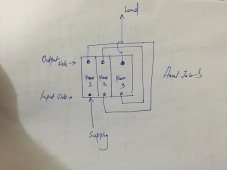DPC
Solar Enthusiast
Years and years ago we used Westinghouse HKD breakers with a thermal magnetic 250 amp trip unit on the little battery locos.
That's breaker rated at up to 400 amps in that frame size, 600 volt AC and an interrupt capacity of 40,000 amps.
All this for a 90 volt loco a couple of small traction motors and battery bank of lead acid that weighed about a ton ( can't recall the ratings on batteries and motors ).
The three phase breaker was on the + DC side of the pack and used to protect the loco in case of a short and as a disconnect mean for the pack when it was removed for charging ( those were a 300 amp 90 volt exide unit as I recall )
The AC K frame breaker was wired so current went in one phase down a jumper connected that to the incoming of the middle phase and the that fed the top of the third phase... ( confused? all three sections of the three phase breaker were wired in series does that sound better ? )
All these little breakers are scary and made in China and some are fakes too.
Fuses only have to work once and they tend to be much more reliable.
Uses fuses for protection and breakers like these little biscuit units as Isolation devices and you will sleep better.
Or buy something expensive, big and proven to do the job

You know what really impressed the hell out of most guys I worked with who ran the trains?
When the power was out I would bring a Loco over and strip the wires off the coffee maker and feed it off the loco battery pack.
At least we had hot coffee while we waited for power to be restored.....
That's breaker rated at up to 400 amps in that frame size, 600 volt AC and an interrupt capacity of 40,000 amps.
All this for a 90 volt loco a couple of small traction motors and battery bank of lead acid that weighed about a ton ( can't recall the ratings on batteries and motors ).
The three phase breaker was on the + DC side of the pack and used to protect the loco in case of a short and as a disconnect mean for the pack when it was removed for charging ( those were a 300 amp 90 volt exide unit as I recall )
The AC K frame breaker was wired so current went in one phase down a jumper connected that to the incoming of the middle phase and the that fed the top of the third phase... ( confused? all three sections of the three phase breaker were wired in series does that sound better ? )
All these little breakers are scary and made in China and some are fakes too.
Fuses only have to work once and they tend to be much more reliable.
Uses fuses for protection and breakers like these little biscuit units as Isolation devices and you will sleep better.
Or buy something expensive, big and proven to do the job
You know what really impressed the hell out of most guys I worked with who ran the trains?
When the power was out I would bring a Loco over and strip the wires off the coffee maker and feed it off the loco battery pack.
At least we had hot coffee while we waited for power to be restored.....
Last edited:



